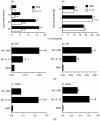Interleukin-12 modulates T-cell responses to microfilariae but fails to abrogate interleukin-5-dependent immunity in a mouse model of onchocerciasis
- PMID: 10583601
- PMCID: PMC2326952
- DOI: 10.1046/j.1365-2567.1999.00891.x
Interleukin-12 modulates T-cell responses to microfilariae but fails to abrogate interleukin-5-dependent immunity in a mouse model of onchocerciasis
Abstract
Infection of mice with microfilariae of Onchocerca lienalis induces high levels of protective immunity to reinfection, which is dependent on interleukin (IL)-5 but not IL-4. Here, we have investigated the effect of exogenous IL-12 administration during either the priming or effector phases of the immune response. When administered during priming, IL-12 induced down-regulation of parasite-specific serum immunoglobulin (Ig)E and up-regulation of IgG2a. Antigen-specific IL-4 responses were strongly suppressed, whilst blood eosinophil levels were partially reduced. When administered during a challenge infection, IL-12 did not significantly influence the balance of antibody isotypes, but partially reduced eosinophil production. Antigen-specific IL-4 responses were again completely ablated. Unusually, interferon-gamma (IFN-gamma) responses were not significantly affected following IL-12 administration, either during priming or after challenge infections. Moreover, despite a fall in antigen-specific IL-5 production, the expression of IL-5-dependent immunity, as determined by reduction in worm recoveries, was fully maintained. These data demonstrate that parasite-induced IL-4 can be abrogated without affecting protective immunity to Onchocerca microfilariae in mice. In view of the established role of IL-4 in pathogenesis, this may have important implications for the development of immunoprophylaxis aimed at microfilariae and the alleviation of pathology in onchocerciasis.
Figures




References
-
- World Health Organisation. Report of a WHO expert committee on onchocerciasis control. WHO Tech Report Ser. 1995;852:1. - PubMed
-
- Ottesen EA. Immune responsiveness and the pathogenesis of human onchocerciasis. J Infect Dis. 1995;171:659. - PubMed
-
- Sher A, Coffman RL. Regulation of immunity to parasites by T cells and T cell‐derived cytokines. Annu Rev Immunol. 1992;10:385. - PubMed
-
- Urban JF, Madden KB, Svetic AI, et al. The importance of Th2 cytokines in protective immunity to nematodes. Immunol Rev. 1992;127:205. - PubMed
Publication types
MeSH terms
Substances
LinkOut - more resources
Full Text Sources

